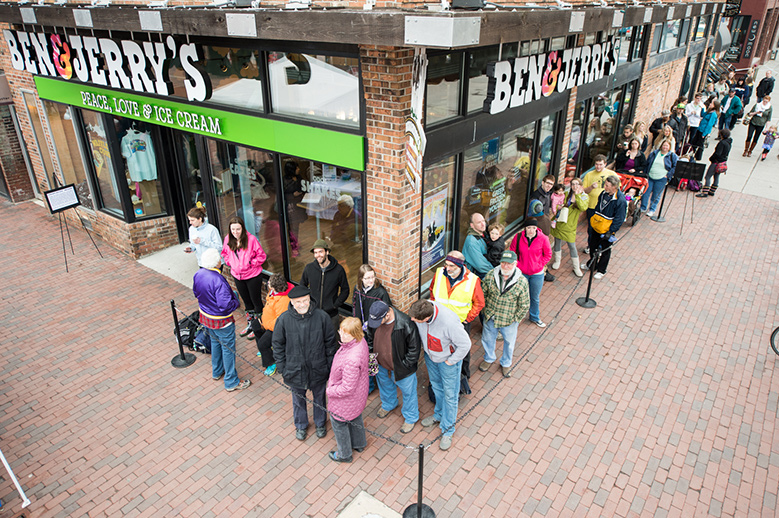They’ll be lined up around the block because the price is too low–just like every day on urban roads
Today’s that day, folks. Ben and Jerry are giving away free ice cream to everyone who comes by their stores. Whether you’re hankering for Cherry Garcia or Chunky monkey, you can now get it for absolutely zero price.
Well, there is that one thing: You’re going to have to wait in line, and probably for a long time. As you’re standing there, it would be a good time for you to ponder the valuable lesson that Ben and Jerry are providing in the fundamentals of transportation economics.

You’ll note that unlike the average day at a Ben and Jerry’s, when you might have to wait in line a for a minute or two to get your favorite flavor, now you’re going to end up waiting twenty minutes, or a half hour, or possibly longer. In terms of customers served and gallons scooped, this is going to be their biggest day of the year–last time they gave out a million scoops of ice cream worldwide.
You’ll probably also notice that most of the people standing in line are people who aren’t working nine-to-five. Not many investment bankers or plumbers, but lots of students, moms with small kids, and people who have at least part of the day off from work.
Make no mistake, although you’re not laying out any cash for your ice cream, you are paying for it: with your time. Let’s say that you’d pay $2.50 for that scoop of Phish Food (they’re a bit smaller than regulation on free cone day). If you have to wait half an hour, and you value your time at say, $15.00 per hour, that $2.50 scoop really cost you something like $7.50. It’s a safe bet that most of the people waiting in line value their time at something less than $5.00 an hour if they’re willing to wait that long for a “free” cone. Also, if you really want ice cream, and are pressed for time, there’s no way that you’re going to jump to the head of the line no matter how much you’d be willing to pay.

Substitute “freeway” for “free cone” and you’ve got a pretty good description of how transportation economics works. When it comes to our road system, every rush hour is like free cone day at Ben and Jerry’s. The customers (drivers) are paying zero for their use of the limited capacity of the road system, and we’re rationing this valuable product based on people’s willingness to tolerate delays (with the result that lot’s of people who don’t attach a particularly high value to their time are slowing down things for everyone).
If Ben and Jerry’s were run by traffic engineers, instead of smart business people (albeit smart business people with a strong social minded streak), they’d look at these long lines and tell Ben & Jerry that they really need to expand their stores. After all, the long lines of people waiting to get ice cream represent “congestion” and “delay,” that can only be solved by building more and bigger ice cream stores. And thanks to what you might call the “fundamental law of ice cream congestion” building more stores might shorten lines a little, but then it would likely prompt other people to stand in line to get free ice cream, or to go through the line twice. But, of course, with zero revenue Ben & Jerry would find it hard to build more stores.
No doubt Ben and Jerry generate enough good will, and probably attract a few new customers with their willingness to give up one day of revenue per year. And they’ll make more than enough money on the other 364 days of the year to cover their losses. But what works for ice cream one day a year is an epic failure when it comes to roads. As long as the price is zero, there will be more demand than you can handle, and you’ll be struggling to pay for the capacity that (you think) is needed.

